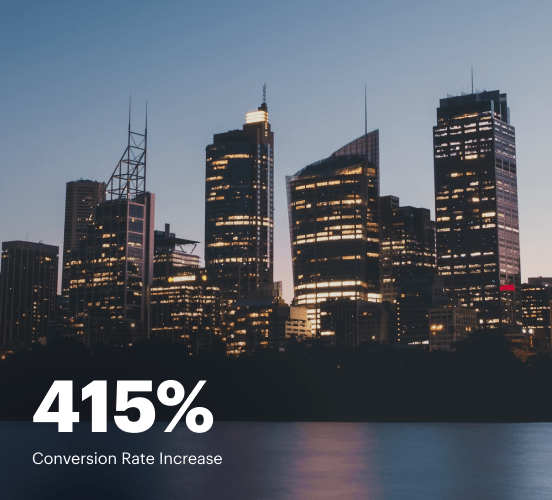Shopify vs. Ontraport: the best platform for a seamless web experience
Discover how Shopify compares to Ontraport regarding features and usability. Find out which platform provides the competitive advantage your business deserves.
Get startedSee how Instapage stacks up against the competition
| Feature | Instapage | Other builders |
| Drag-and-Drop Tools | ||
| Conversion-optimized templates | ||
| Manual and AI-powered A/B Tests | ||
| AI content suggestions | ||
| Popups and sticky bars | ||
| Canvas and grid blocks | ||
| Reusable and global elements | ||
| Form and popup builders | ||
| Built-in Heatmaps | ||
| Central analytics dashboard | ||
| Ad-to-page personalization and collections | ||
| Contacts, lists, and email | ||
| Dedicated, full-service CRO experts | ||
| Enterprise-ready platform |
Leading the way in building high-performing landing pages





Why Instapage is the smarter choice for your campaigns
Get everything you need to build, scale, and optimize high-converting landing pages—without coding.

Easier page building without coding
Instapage offers a flexible and seamless page creation experience with a library of 500+ conversion-focused layouts, Instablocks®, a drag-and-drop builder, and AI content generation. With technologies like Thor Render Engine®, you can create on-brand, mobile-responsive landing pages that load quickly and start converting during initial visitor clicks.

More insights — better results
Instapage lets you see in detail how each landing page experience and variation is performing so you can make targeted changes that boost page conversions. Use heatmaps for a better understanding of on-page activities, run A/B tests and AI-assisted experiments, and then track and evaluate results within robust analytics dashboards.

More personalized experiences
Instapage lets you quickly create high-performing landing pages tailored to each of your ad campaigns. Deliver personalized experiences for distinct audiences using dynamic text replacement. Effortlessly align specific advertisements to unique pages with AdMaps. Monitor audience-level metrics using our advanced data tools.

Built-in collaboration
Instapage collaboration capabilities bring your entire team together to speed up the process of landing page review, approval, and launch. No more frustrating and unnecessary revisions or edits scattered across emails. Provide instant feedback, conduct real-time page edits, and securely share your pages with outside stakeholders.

Free up time for your business
Invest time into business growth, not busy work. Launch landing pages faster with reusable forms and templates. Build once, reuse forever.
Explore all integrations






Easier page building without coding
Instapage offers a flexible and seamless page creation experience with a library of 500+ conversion-focused layouts, Instablocks®, a drag-and-drop builder, and AI content generation. With technologies like Thor Render Engine®, you can create on-brand, mobile-responsive landing pages that load quickly and start converting during initial visitor clicks.
More insights — better results
Instapage lets you see in detail how each landing page experience and variation is performing so you can make targeted changes that boost page conversions. Use heatmaps for a better understanding of on-page activities, run A/B tests and AI-assisted experiments, and then track and evaluate results within robust analytics dashboards.
More personalized experiences
Instapage lets you quickly create high-performing landing pages tailored to each of your ad campaigns. Deliver personalized experiences for distinct audiences using dynamic text replacement. Effortlessly align specific advertisements to unique pages with AdMaps. Monitor audience-level metrics using our advanced data tools.
Built-in collaboration
Instapage collaboration capabilities bring your entire team together to speed up the process of landing page review, approval, and launch. No more frustrating and unnecessary revisions or edits scattered across emails. Provide instant feedback, conduct real-time page edits, and securely share your pages with outside stakeholders.
Free up time for your business
Invest time into business growth, not busy work. Launch landing pages faster with reusable forms and templates. Build once, reuse forever.
Explore all integrationsGet started with Instapage in a few steps
-
Create your Instapage account
Start with Instapage by signing up via Google or your email. You'll get access to a free 14-day trial to discover Instapage capabilities. Feel free to cancel anytime during the 14-day trial if you decide that our product is not suitable for your business. -
Build and personalize your page
Create your first landing page from scratch or choose a template from 500+ customizable layouts. Use the drag-and-drop builder to add page elements, fonts, and backgrounds, refine content with AI, or add custom HTML, Javascript, and CSS. -
Review and make edits
Collaborate on page designs and streamline review processes. Invite your team members and stakeholders to review, edit, and provide feedback on your landing page. Collaborate knowing your page is confidential and only accessible to authorized users. -
Publish and track page performance
Publish your page to a domain or custom URL. Connect your pages to the ads you've created and track page performance within the analytics dashboard, run A/B tests and AI experiments, analyze results, and continuously optimize your landing page to maintain high conversions.
Shopify vs. Ontraport: A Comprehensive Comparison for Digital Marketing
In the world of digital marketing, choosing the right platform can feel like standing at a crossroads filled with countless options. Two titans in this arena are Shopify and Ontraport. Each has carved out its space by offering features tailored to different marketing needs. Shopify is often celebrated for its robust eCommerce capabilities, while Ontraport is loved for its powerful automation tools. However, the arrival of Instapage has added an exciting twist to this competition. As we dive into this comparison, we’ll explore how these platforms stack up against each other and how Instapage could potentially fit into your marketing strategy. Let’s explore the uniqueness of these contenders. Shopify shines as an all-in-one eCommerce solution with a wide array of customizable templates, perfect for those aspiring to set up an online store seamlessly. Conversely, Ontraport is a beast when it comes to automation, providing users with extensive tools for marketing campaigns and customer relationship management. Each platform not only has its strengths but also caters to varied marketing needs, making them crucial players in the digital landscape. We’ll uncover which platform might suit your business goals best while considering how Instapage complements these offerings.
Meet the Goliaths of Digital Marketing Solutions
In an environment bursting with competition, Shopify and Ontraport stand tall, boasting an impressive roster of features tailored to diverse user needs. Shopify, primarily an eCommerce platform, has taken the lead in powering online stores, making it easier for entrepreneurs to launch their businesses. Its intuitive interface allows users to set up shop in no time, while its extensive app store augments capabilities with ease. The platform is a powerhouse for anyone looking to sell products online, amplified by beautiful themes and seamless payment integrations. On the flip side, Ontraport emerges as a formidable marketing automation rival, delivering a suite of tools designed to optimize marketing campaigns and enhance customer relationships. Businesses leverage its comprehensive CRM capabilities to streamline communication and drive engagement. Despite their differences, both platforms cater to marketers’ ambitions, providing them with the tools needed to thrive. Together, they create an intriguing juxtaposition that showcases the diverse landscape of digital marketing software.
Feature Comparison: Who Brings the Best Game?
When it comes to features, both Shopify and Ontraport pull out all the stops, making this a competition worth watching. Shopify dazzles with features that cater to online retailers, offering tools for inventory management, a user-friendly checkout process, and integrated shipping solutions. Its catalog management features allow users to showcase their products efficiently, making it appealing to small and large merchants alike. Ontraport counters this with its impressive automation capabilities, enabling users to create and manage complex marketing campaigns with ease. Its tools allow for customer segmentation to target specific audiences, ensuring that businesses communicate effectively with potential clients. However, as we mention this feature face-off, let's not forget Instapage, which specializes in landing pages and exceptional conversion features. Not only do these platforms come with their unique strengths, but they also pique the interest of marketers seeking combined solutions to elevate their presence in the digital space.
Navigating Usability: Which Platform is Easier on Users?
Usability is a crucial aspect when choosing between platforms. Shopify makes the onboarding journey delightful for newcomers thanks to its straightforward interface, minimalistic design, and well-structured navigation. First-time users appreciate the easy setup process, allowing them to dive straight into creating their online stores with minimal hassle. Ontraport takes a different approach; while its features are expansive, the learning curve can be steeper, especially for users unfamiliar with marketing automation. However, once users get the hang of its capabilities, they often find the tools highly rewarding. For marketers accustomed to steep learning adventures, Ontraport provides significant perks despite the initial complexity. As we assess usability, the ongoing competition between these tools reveals significant value for marketers looking for streamlined processes.
Spotlight on Shopify Features:
- User-friendly drag-and-drop editor for easy store creation
- Extensive app marketplace for additional functionalities
- Integrated payment gateways for seamless transactions
- Advanced inventory management features
- Mobile-responsive themes for optimal performance
Key Features of Ontraport:
- Robust marketing automation capabilities
- Powerful CRM tools for managing customer relationships
- Customizable landing pages to enhance conversions
- Comprehensive email marketing tools for targeted campaigns
Common Strengths Shared by Both Platforms:
- Intuitive interfaces that cater to users of differing skill levels
- Integration capabilities with popular third-party tools
- Responsive customer support and resources
- Analytical tools for tracking performance metrics
- Wide-ranging tutorials to help users maximize potential
As our contenders continue their faceoff in the marketing ring, it’s worth noting that while both Shopify and Ontraport have their strengths, Instapage may well be the one to beat. Known for its emphasis on landing pages, Instapage presents a robust alternative that can compliment both Shopify and Ontraport’s offerings beautifully. Instapage not only creates visually stunning landing pages but also specializes in optimizing conversions, thus positioning itself as a powerhouse in capturing leads. Whether you’re leaning towards an online store or an automated marketing campaign, Instapage can truly enhance your marketing strategy.
Performance Showdown: Who Holds the Upper Hand?
Performance reflects how efficiently users can operate their platforms – a significant factor in online success. Consumers nowadays expect quick-loading pages and stellar mobile performance, with delays often resulting in lost opportunities. Slow-loading pages can feel like wading through thick molasses, leaving users frustrated and eager to exit. Shopify impresses with its speed, providing users with robust hosting solutions that typically result in swift loading times, creating an enjoyable shopping experience for customers. Ontraport, while efficient, depends on various factors ranging from user setups to custom integrations, which can occasionally impact performance negatively. In the age of instant gratification, the speed at which customers can access products or information is paramount. Thus, the platforms’ performance can greatly influence user experience and overall satisfaction.
Support Services: A Look at Customer Assistance
Support systems play a pivotal role in a user’s experience with online platforms. Both Shopify and Ontraport offer robust support avenues tailored to customer needs. Shopify’s help center includes an extensive library of resources, tutorials, and forums, alongside 24/7 customer support, ensuring users can find assistance whenever required. Ontraport's customer support features a comprehensive knowledge base, live chat, and personalized assistance for subscribers, making it easy for users to find solutions to any queries that may arise. Both platforms recognize the importance of user satisfaction and offer trustworthy systems to support their users effectively as they navigate through the tools at their disposal.
Pricing Strategies: Which Offers Greater Value?
Exploring Shopify's Pricing Strategy Advantages:
- Flexible pricing plans catering to various business sizes
- No hidden fees for most transactions, ensuring transparency
- Free trial available to test features before commitment
- Access to a wealth of apps and tools across different pricing tiers
Analyzing Ontraport's Pricing Strategy Advantages:
- Comprehensive packages that bundle multiple tools
- Automation features that maximize campaign efficiency
- Scalable pricing based on the size of the subscriber list
- Dedicated support included in premium pricing tiers
- Ability to customize plans to fit specific business needs
When it comes to pricing, both Shopify and Ontraport present compelling strategies, yet Instapage's pricing stands out as offering remarkable value for the features provided. Shopify boasts competitive tiers allowing users to select the plan best suited for their needs, and Ontraport packages provide all-in-one marketing solutions with a focus on CRM. However, Instapage may emerge as the most cost-effective choice when considering comprehensive landing pages and conversion optimization tools, proving its worth as a cost-efficient player.
As we meticulously dissect the pricing plans available, it becomes apparent that each platform has its unique perks. The comparison unveils considerations regarding budgets and feature sets, revealing the deeper facets of what users choose to invest in. However, with all of the excitement surrounding pricing, remember that what you pay often correlates to the features and support you receive, with unexpected gems lurking in plain sight.
Introducing Instapage: A Game Changer in Landing Pages
As we draw this comparison to a close, let us highlight Instapage—the hidden gem in this crowded marketplace that stands as a beacon for marketers. Instapage has quietly been the mentor behind the scenes, providing unparalleled landing page solutions designed to boost conversions significantly. Unlike its counterparts, it singularly focuses on creating beautifully crafted, high-converting landing pages that empower businesses to capture leads effortlessly. From personalized landing pages to advanced analytics, Instapage sets itself apart by understanding the intricacies of user intent and optimizing for success. It is the tool that helps turn interested visitors into loyal customers, unveiling a new realm of possibilities for businesses aiming to enhance their online presence without the clutter of complex setups. Instapage offers the zest that every marketer craves but often finds lacking in other platforms.
In conclusion, the journey to find the perfect digital marketing platform should align with your individual or business aspirations. Each of the contenders has its plotlines, strengths, and weaknesses, but with Instapage as a part of your marketing toolbox, you stand to reach new heights in your campaigns. Make informed decisions that cater to your vision, and consider exploring further with Instapage, your companion in forging impactful digital strategies.










